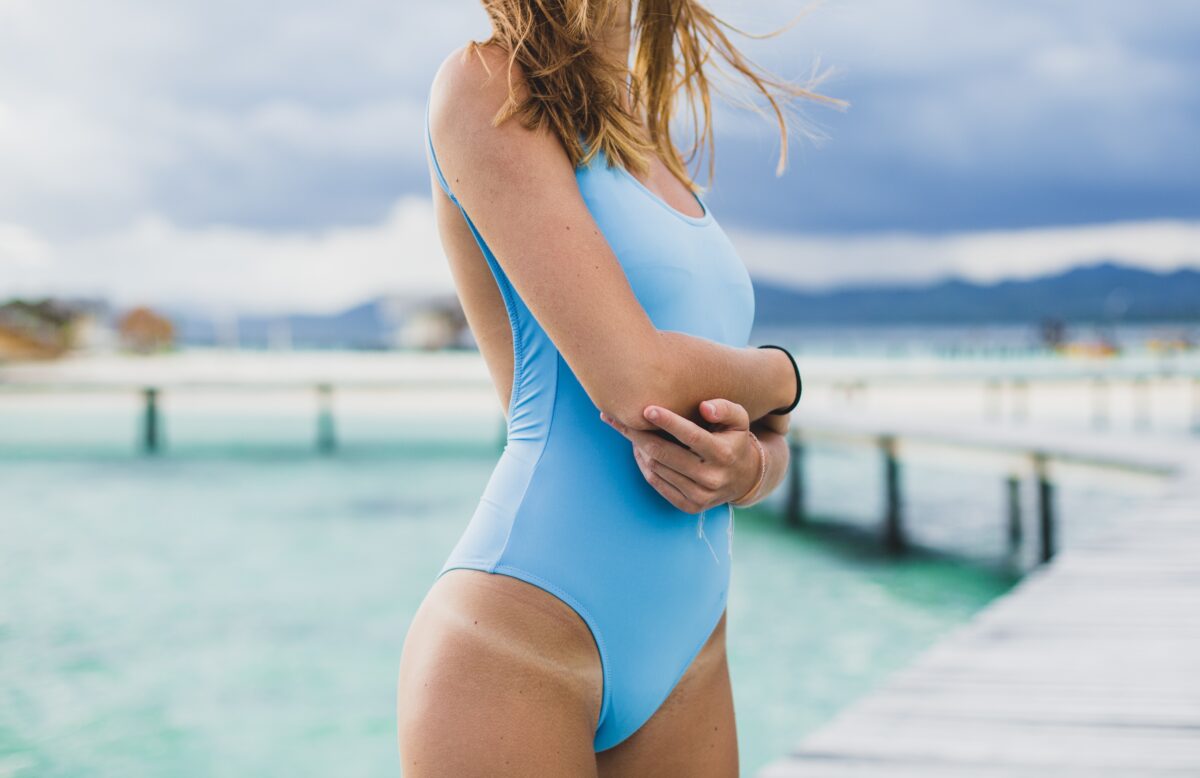After looking for swimsuit styles that can provide me with support, comfort, and modesty to no avail, I delved yet into another problem: searching for what to wear under a swimsuit. My endeavor was fruitful, and in this guide, I will share with you a list of clothes you can layer underneath the swimsuit to improve comfort, support, and coverage.
Contents
What to Wear Under a Swimsuit
Even when I wore swimsuits with built-in supports, such as bras, the support was not enough, and my bust was drawing contours on the wet fabric. Usually, this caught people’s attention and made me self-conscious.
Additionally, if I swam for long, my legs would chaff, and the muscles would be sore. After trying many swimsuit styles, I discovered you could get more support, comfort, and coverage by getting a swimsuit without built-in support and wearing the following attires underneath.

Swim Bras
A swim bra is made from materials such as nylon, spandex, and polyester. That makes it ideal for swimming garments as the material is lightweight and quick drying. The material doesn’t absorb water, which usually makes bras heavy and uncomfortable to swim with. This is why cotton clothes are not allowed in swimming pools due to their absorbency.
These fabrics are also resistant to water damage, allowing your bra under swimsuit to withstand exposure to saltwater found in oceans and chlorine in swimming pools. The bras come in a variety of styles, including underwire, strapless, molded cups, and racerback, allowing you to layer your swimsuit with your preferred style.
They are also designed to fit snugly without riding up and down. Generally, these bras offer extra support to your breasts compared to the built-in swimsuit bras. This is an added advantage if you have larger breasts and need extra support to prevent breast ligaments from weakening.
Swim Briefs
Swim briefs, also known as speedos, are typically worn by men when swimming. They are ideal for wearing underneath swimsuits as they can help provide support for the groin and buttocks. This is important for swimmers who perform high-impact activities, such as diving.
They make the swimmer streamlined as they do not add extra layers under your swimsuit. This ensures minimal drag in the water while allowing for greater comfort. Some feature a drawstring and an elastic waistband which helps prevent the briefs from slipping down or riding up.
Swim Leggings
Swim leggings, also known as swim tights, are specifically designed for water activities and are an ideal option for wearing under swimsuits as they provide additional coverage to the legs. This helps protect the legs from irritants in salty water, such as sea lice and swimmers’ itch.
The materials used to design these leggings are usually UPF-rated, which is how much UV radiation, both UVB and UVA, the fabric allows to reach your skin. These types of materials are best and ideal for leggings.
That means you can use these legs to protect the skin from harmful ultraviolet rays when surfing. They can also be good layering for added warmth. Meanwhile, swim leggings are different from TC leggings and are not advisable for swimming.

Compression Shorts
Compression shorts are designed to improve blood flow and aid in muscle recovery. Wearing compression shorts designed for swimming under your swimsuit helps reduce muscle soreness and fasten recovery when taking a break from water activities such as swimming and wakeboarding.
This makes them a great layering if you are engaging in swimming as an intense exercise. They also provide an additional layer of coverage to your lower body, minimizing friction between the legs. This type of shorts is what you should also wear under a wetsuit due to its nice material.
Bra Pads
Bra pads come in a wide array of styles and designs. They are designed from chlorine-resistant silicone and foam materials, ensuring that they will not break down when exposed to chlorinated water in swimming pools.
If your swimsuit lacks built-in support at the bust area and features pockets where you can insert bra pads, simply fit water-resistant pads in the pockets to mold and support your bosom.
If the swimsuit doesn’t have pockets for inserting the pads, you should know how to put padding on your one-piece. Place the pads between the lining and the fabric of the swimsuit to get the desired support.
Camisole
A camisole is a great option to layer under the swimsuit as it provides support and coverage without being too bulky and restrictive.
Simply try different combinations to ensure that the camisole doesn’t create visible lines under your swimsuit. It is also advisable to choose one that complements the neckline and style of your swimsuit for a cohesive look.

How to Tell if a Swimsuit Has Underwear-Like Features
Most swimsuits are designed with built-in underwear that offers the same function as a typical bra and a pair of underwear. Although this relieves you of the hassles of having to get undergarments separately, you might not be able to wear your preferred undergarment in such swimsuits.
If it’s your first time purchasing a swimsuit, you might be confused about whether it has underwear-like features or not. Fortunately, the following are some tips that can help you tell if a swimsuit has built-in underwear or not.
- Check the seams: Swimsuits designed to be worn without underwear have flat seams. If you see raised seams, it’s an indication that the swimsuit is designed to be worn with underwear.
- Look for a mesh lining: A mesh lining in the crotch area of a swimsuit helps provide support and prevent chafing and is a good indication that the swimsuit is designed to be worn without underwear.
- Read the label: Some swimsuits specify on the label whether they are designed to be worn without underwear or not.
- Try on the swimsuit: With the swimsuit on, you can easily know whether it offers the support that underwear offers or not.
- Elastic waistband: Look for an elastic waistband at the top of the swimsuit bottoms. Since this is a common feature in underwear, if the swimsuit has a similar elastic waistband, it may be an indication of a more underwear-like feature.
Related Questions
Can I Wear a Menstrual Pad Under My Swimsuit?
Yes, you can wear a menstrual pad under a swimsuit, provided you choose a dark-colored one, and avoid using pads with wings as they might be visible on the outside. Note that pads can get soaked in water, which can cause hygiene issues such as bacteria and fungi.
What Can I Wear if My Swimsuit Does Not Have Padding?
You can wear nipple covers if your swimsuit does not have padding, as they are made of a soft, silicone material that cannot irritate your skin when in water. Reusable pasties are also a good option, as they are water-resistant and will not fall off easily.
Does What I Wear Under My Swimsuit Affect the Swimsuit Sizing?
Yes, what you wear under your swimsuit can affect the swimsuit sizing. This is because if you wear something thick under your swimsuit, it makes the swimsuit stretch more to accommodate the extra fabric. This can make the swimsuit loose over time.
Final Thoughts
Generally, what to wear under a swimsuit depends on the support and coverage you want. For instance, you can wear a swim bra to prevent breast movements when swimming, compression shorts to reduce muscle soreness, or leggings for additional coverage.
